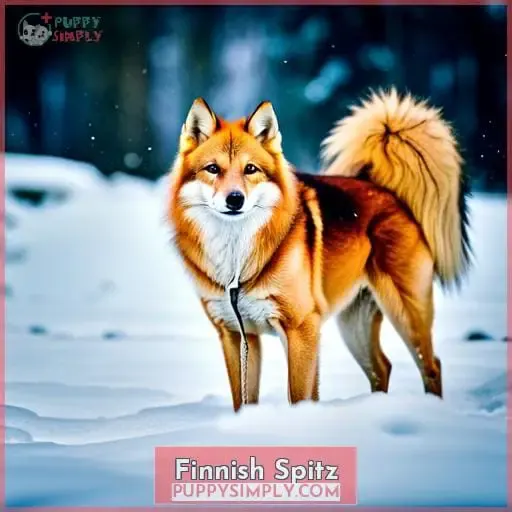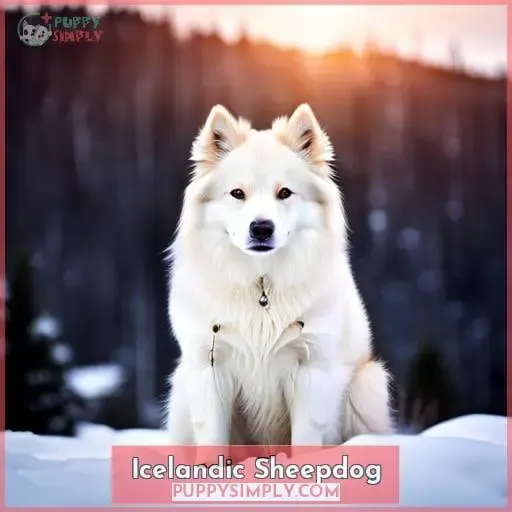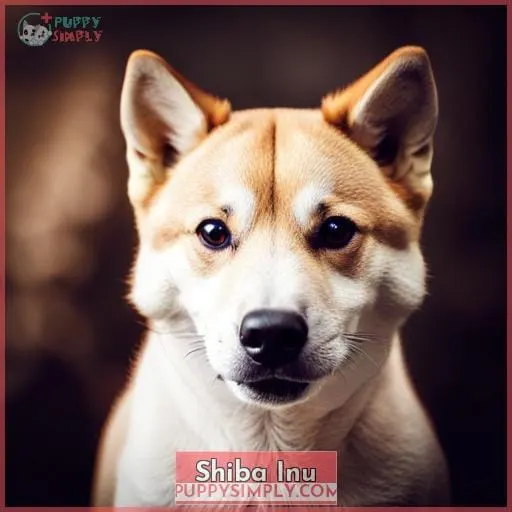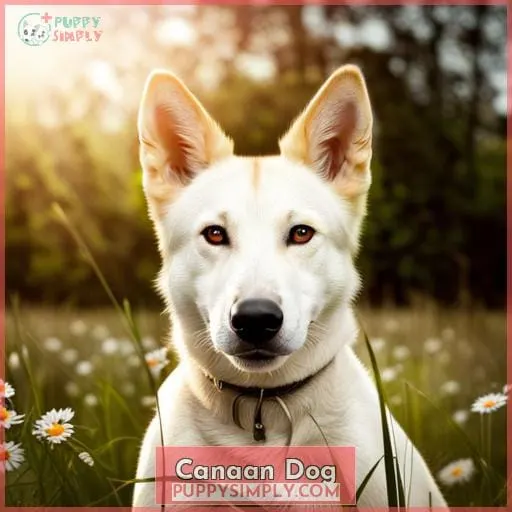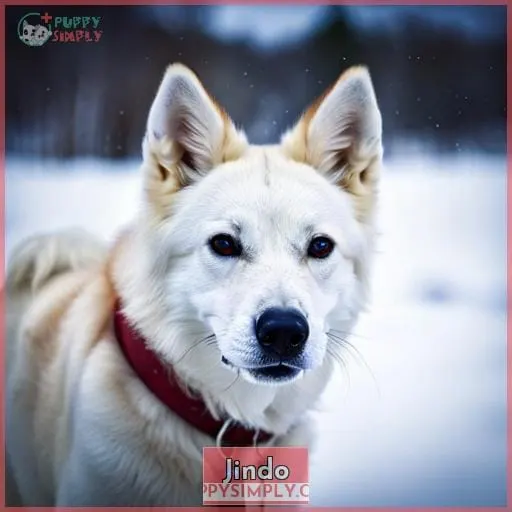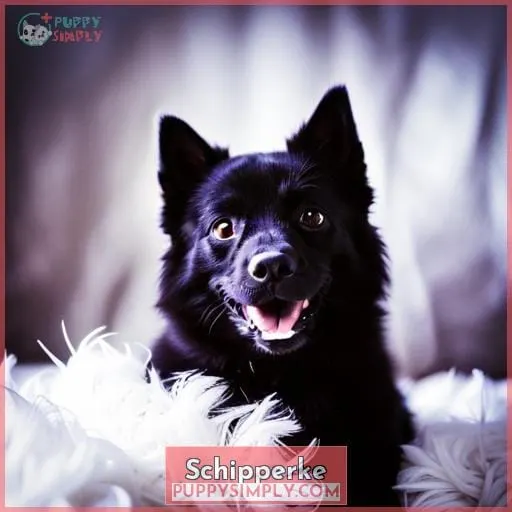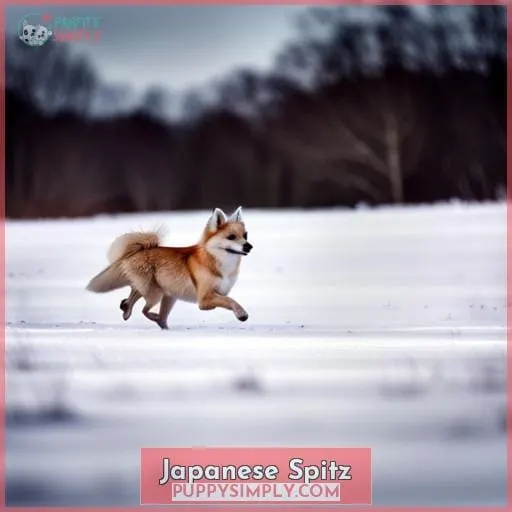This site is supported by our readers. We may earn a commission, at no cost to you, if you purchase through links.
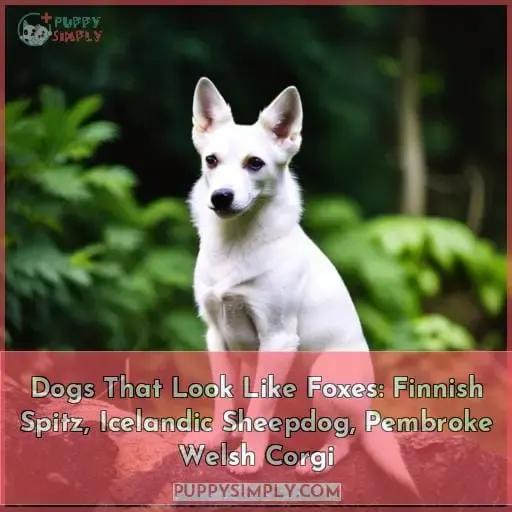 Immerse yourself in the fascinating world of dogs that resemble foxes.
Immerse yourself in the fascinating world of dogs that resemble foxes.
Did you know that breeds like the Finnish Spitz, Icelandic Sheepdog, and Pembroke Welsh Corgi possess distinct features reminiscent of their foxy counterparts? These intelligent and active spitz breeds boast perky ears, pointy muzzles, and curly or bushy tails.
Discover more about these captivating canines as we delve into their origins, characteristics, and unique traits.
Table Of Contents
- Key Takeaways
- Finnish Spitz
- Icelandic Sheepdog
- Pembroke Welsh Corgi
- Shiba Inu
- Canaan Dog
- Basenji
- Jindo
- Schipperke
- Nova Scotia Duck Tolling Retriever
- Japanese Spitz
- Frequently Asked Questions (FAQs)
- What are the specific characteristics that make these dog breeds resemble foxes?
- Are these fox-like dog breeds suitable for families with children?
- How do these fox-like breeds differ in terms of temperament and trainability?
- What are the grooming requirements for these fox-like dog breeds?
- Are there any health concerns or specific care needs associated with these fox-like breeds?
- Conclusion
Key Takeaways
- Dogs that resemble foxes have perky ears, pointed muzzles, and bushy tails.
- They are often independent, intelligent, and adaptable.
- Some breeds that resemble foxes include the Finnish Spitz, Icelandic Sheepdog, and Pembroke Welsh Corgi.
- They require regular grooming to prevent matting and keep their coats in good condition.
Finnish Spitz
If you’re looking for a dog that resembles a fox, the Finnish Spitz is an excellent choice.
With its hunting heritage and Nordic origins, the Finnish Spitz possesses unique characteristics that set it apart from other breeds.
Known for their friendly and outgoing temperament traits, these dogs aren’t only visually appealing but also make wonderful companions.
In terms of grooming needs, the Finnish Spitz has a double coat that requires regular brushing to maintain its appearance and prevent matting or tangling of fur.
Overall, this breed’s fox-like appearance combined with their delightful personality makes them an attractive option for those seeking a canine companion with distinct features reminiscent of our foxy friends in nature.
Icelandic Sheepdog
Now let’s dive into the characteristics of the Icelandic Sheepdog, a breed that shares similarities with foxes.
Originating from Iceland, this Nordic breed is known for its herding instincts and foxy appearance.
Icelandic Sheepdogs come in two coat varieties: long-haired and short-haired, both providing protection against harsh weather conditions.
With their playful temperament and energetic nature, they make excellent companion dogs for active individuals or families.
One unique aspect of this breed is their vocalization – they’ve a distinct bark that sounds like singing or yodeling rather than typical dog barking.
The Icelandic Sheepdog’s ability to herd livestock combined with its affectionate personality makes it an ideal choice for those seeking a loyal and versatile canine companion.
Pembroke Welsh Corgi
Moving on to the Pembroke Welsh Corgi, this breed also bears a resemblance to foxes with its unique characteristics.
The Pembroke Welsh Corgi is known for its short legs, elongated body, and foxy face. These charming dogs have been loved by royalty throughout history and continue to capture hearts today. Despite their small size, they possess an immense amount of companionship and loyalty that makes them perfect family pets.
Corgis are herding dogs by nature and require regular exercise to keep them happy and healthy. Daily walks or playtime in a securely fenced yard will help meet their energy needs. Training these intelligent canines can be both fun and challenging due to their independent streaks, but consistency with positive reinforcement techniques is key.
In terms of size comparisons within the canine family, Pembroke Welsh Corgis stand about a foot tall at the shoulder and weigh up to 30 pounds when fully grown. Their genetic similarity not only gives them physical characteristics resembling foxes but also contributes significantly towards forming strong bonds with humans as well as adapting easily into various living environments.
Shiba Inu
Dogs That Look Like Foxes: Finnish Spitz, Icelandic Sheepdog,
Pembroke Welsh Corgi
Continuing our exploration of dogs that resemble foxes,
let’s now turn our attention toward the fascinating qualities
of the curious yet captivatingShinaInu.
Training Challenges:
The intelligence paired
with independence makes for quite challenging obedience sessions.
Temperament Insights:
Exuding confidence while being wary
of unfamiliar faces; however they remain loyal pals at home!
Ownership Tips:
Engaging these energetic beings in adequate mental stimulation ensures optimum behavior.
Popularity of the Shiba Inu:
This breed has garnered immense
attention worldwide and is currently one of Japan’s most popular companion dogs.
Historical Origins:
With a history dating back to ancient times,
theShibas have their roots embedded in Japanese culture.
The Shiba Inu, with its unique temperament and appearance,
continues to captivate dog enthusiasts around the globe. Understanding
their training challenges, insights into their temperament, ownership tips,
popularity among pet lovers are crucial before considering this charming canine companion!
Canaan Dog
To fully understand the fox-like qualities of Canaan Dogs, you must delve into their history and origins.
The Canaan Dog is a breed with a rich heritage that traces back centuries and has played diverse roles throughout its existence. Originating in ancient Israel, these dogs were used by the Israelites for herding and guarding purposes.
They thrived in the harsh conditions of the Negev Desert, showcasing their resilience and adaptability.
In addition to their historical significance, Canaan Dogs possess distinct traits that contribute to their fox-like appearance. These medium-sized dogs stand up to 24 inches tall and weigh up to 55 pounds. Their temperament is characterized by intelligence, confidence, vigilance – all key attributes shared with foxes.
Today’s Canaan Dogs continue to demonstrate versatility as they’ve taken on various roles such as service dogs, messengers during wartime situations,
landmine detectors,
and even guide dogs for individuals with disabilities.
Their unique combination of size,
temperament,
and physical characteristics make them an intriguing breed among dog enthusiasts looking for companionship combined with striking visual appeal.
Basenji
Now let’s delve into the unique qualities of the Basenji, a breed that shares a resemblance to foxes. The Basenji is known for its barkless charm, making it an intriguing member of the canidae family.
- Barkless Charm: One of the most distinctive features of the Basenji is its lack of barking. Instead, they possess vocalization wonders like chortles and yodels that add to their allure.
- Cultural Symbolism: In ancient Egyptian culture, Basenjis held significance and were depicted in artifacts as symbols of elegance and grace.
- Training Challenges: While intelligent, training a Basenji can be challenging due to their independent nature. They require patient guidance and consistent reinforcement.
With their fox-like elegance and unique traits such as being barkless dogs with cultural symbolism attached to them, owning a Basenji comes with both rewards and challenges in training one effectively while appreciating their distinct characteristics within your household or community setting.
Jindo
As we delve into the world of dogs that resemble foxes, let’s explore the unique characteristics of the Jindo breed.
Jindos originate from the island of the same name near Korea where they’ve coexisted with islanders for thousands of years as hunting dogs and watchdogs.
Their island heritage has shaped certain traits – Jindos are known for their hunting instincts, escape artist tendencies testing boundaries, and a dignified, confident demeanor.
While loyal companions, Jindos can present training challenges with their strong wills. However, they’re eager to please and form close bonds once trust is established through firm, positive reinforcement methods valuing the relationship above all else.
Considered national treasures in Korea today, Jindos carry an air of independence and quiet strength passed down over generations.
Schipperke
You’ll find the petite Schipperke resembles a small black fox. This breed stands 13 inches or less with a playful and mischievous temperament, requiring plenty of activity and training to channel their energetic spirit.
Originally bred in Belgium to catch rats and watch over cargo on ships, they’ve adapted well to modern apartment living. However, their roots as independent workers are evident in their tendency to be stubborn and aloof at times.
Their soft and lush coats demand consistent grooming to manage shedding. Ultimately, the Schipperke’s unwavering affection and loyalty toward their families make them eerie fox-like look-a-likes that thrive as lively outdoor adventure companions.
Nova Scotia Duck Tolling Retriever
From the high-energy Schipperke, you’d turn to the compact, fox-like Nova Scotia Duck Tolling Retriever. This versatile retriever has a thick double coat suited for cold climates, requiring diligent grooming.
Resembling a red fox in miniature form, its moderate energy levels and eager-to-please temperament make it a delightful companion. However, be prepared to provide plenty of daily exercise and stimulation for this bright breed to prevent boredom or destructive behaviors.
Originating from Nova Scotia, Canada, the Toller was bred to lure waterfowl within gunshot range for hunters. Despite its hunting instincts, it integrates well into family life with proper training. Training techniques focus on positive reinforcement to curb stubborn tendencies.
Providing adequate outlets for exercise and mental stimulation will result in a friendly, playful fox-like dog.
Japanese Spitz
Another fox-like breed you’re gazing at is the Japanese Spitz, originating from smaller spitz dogs like the German Spitz and the white Keeshond. Playful and lively, these petite pups bear a striking resemblance to Arctic foxes with their pristine white coats, perky ears, and curled tails.
While highly trainable and eager to please, consistency is key when housebreaking a Japanese Spitz.
| Trait | Description |
|---|---|
| Size | Up to 15 inches tall, 25 pounds |
| Coat | Double-layered, thick and white |
| Temperament | Smart, friendly, cheerful |
| Activity Level | Moderate energy, enjoys play |
As true companion dogs, they crave being around their owners and may suffer separation anxiety. Daily walks and play sessions are a must to meet their activity requirements. With proper socialization, these adaptable dogs thrive in apartments, mingling well with polite children and pets when respected.
Frequently Asked Questions (FAQs)
What are the specific characteristics that make these dog breeds resemble foxes?
Distinctive fox-like traits in these breeds include:
- Perky ears
- Pointy muzzles
- Bushy tails
- Often a double coat, resembling foxes.
Their independent nature, intelligence, and adaptability contribute to their striking resemblance to these wild canids.
Are these fox-like dog breeds suitable for families with children?
When considering fox-like dog breeds for families with children, it’s important to assess their temperament and compatibility.
While some may be affectionate and playful companions, others might exhibit possessiveness or aloofness towards strangers.
How do these fox-like breeds differ in terms of temperament and trainability?
Fox-like breeds vary in temperament and trainability.
Shiba Inus and Akitas exhibit independence, needing patient training.
Basenjis’ intelligence requires mental stimulation.
Keeshonds and Alaskan Klee Kais display loyalty and adaptability, aiding easier training experiences.
What are the grooming requirements for these fox-like dog breeds?
You need to groom these fox-like breeds regularly due to their thick double coats.
Are there any health concerns or specific care needs associated with these fox-like breeds?
Yes, there are some health concerns and specific care needs associated with these fox-like breeds.
These include:
- Potential for overheating
- The need for regular grooming
- The potential for separation anxiety
Conclusion
When observing the Pembroke Welsh Corgi’s bushy tail and pointy ears, one might mistake it for a fox. Yet despite certain vulpine similarities in appearance and temperament across breeds like the Finnish Spitz, Icelandic Sheepdog, and Shiba Inu, these dogs retain uniquely endearing canine qualities.
Though their foxy features may captivate, remember that breeds possessing such attributes are still very much dogs at heart. Appreciating both their similarities and differences allows us to cherish these delightful dogs that look like foxes for exactly what they are.

